Other tokens from Durango
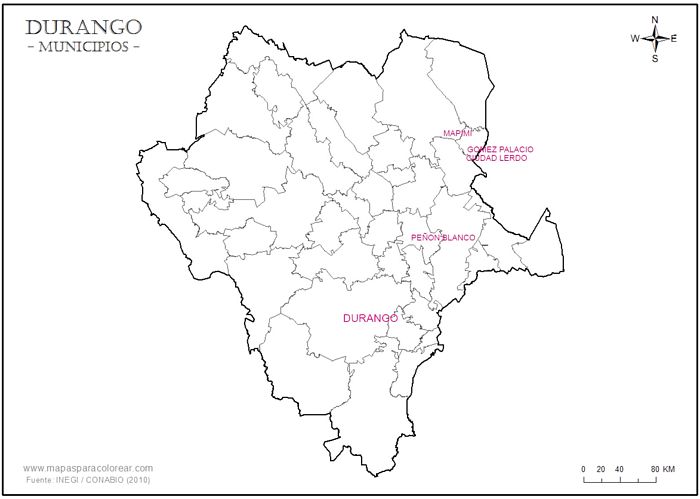
Ciudad Lerdo
Hotel Madrid
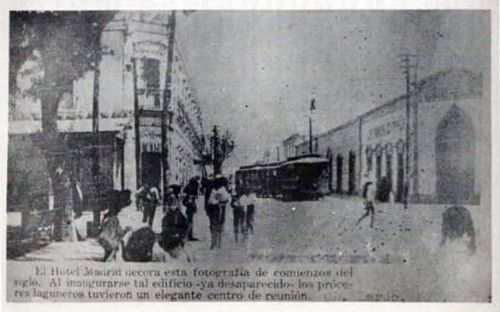
The Hotel Madrid in 1893
The Hotel Madrid, facing the plaza, was run by Eugenio GorasaveThe Mexican Herald, Vol. III. No. 86, 27 May 1897.
Grove 1670
Obverse: EUGENIO GOROSAVE / HOTEL MADRID / C. LERDO, DGO.
Reverse: 1000
30mm. brass
Obverse: HOTEL MADRID / CD. LERDO / DGO.
Reverse: UNA / COPA
These were made by L. H. Moise, S. F.
La Numancia
La Numancia was a famous picnic area and canteen, located in the southwest corner of the intersection formed by calle Allende and calle [ ] (now Madero) . At the end of the 19th century, when its owner was Sebastián Vera Ortega, it was most important social centre in the city, with a small orchestra.
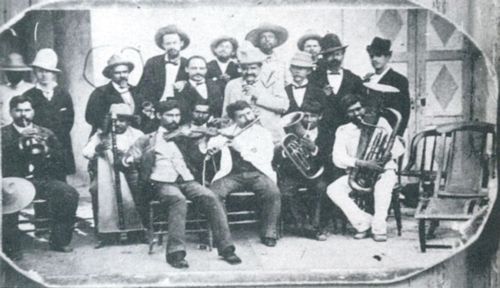
The orchestra at La Numancia at the end of the 19th century. The owner, Sebastián Vera Ortega, stands behind the harpist.
La Numancia, in its final years, functioned just as a bar and closed in the 1980s.
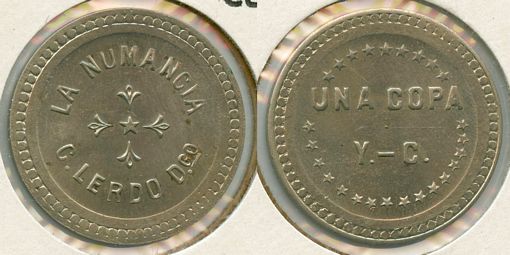
Obverse: LA NUMANCIA / C. LERDO DGO
Reverse: UNA COPA / Y - C.
Durango
Comedor del Durango
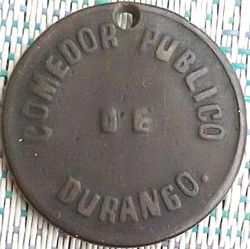
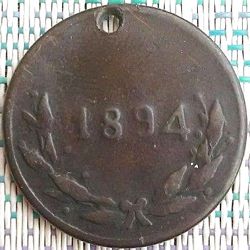
Obverse: COMEDOR PUBLICO / DE / DURANGO.
Reverse: 1894
listed in Grove's Medals of Mexico as 302b
La Providencia
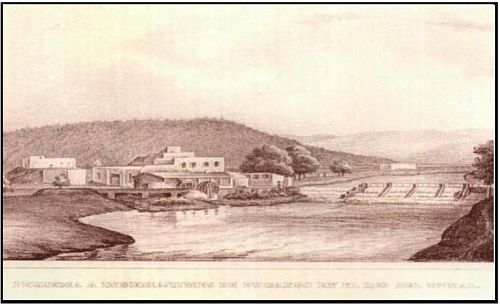
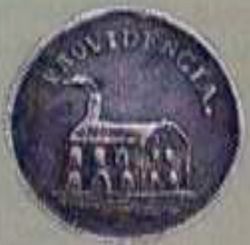
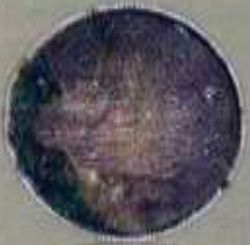
The cotton cloth factory, La Fábrica de Hilados y Tejidos “El Tunal”, also called “La Providencia”, was situated on the banks of the river Tunal, in El Pueblito, now virtually a suburb of the city of Durango. The factory was founded by the German, Hermán Stahlknecht, and the Spaniard, José Fernando Ramírez Alvarez, in 1837.
José Fernando was born in Hidalgo del Parral, Chihuahua, on 5 May 1804, studied at universities in Durango and Zacatecas and graduated as a lawyer in 1832. He was Deputy for Durango in 1833 and 1842, and from 1841 to 1852 held various public appointments: Secretario de Gobierno, Presidente of the Tribunal Mercantil and of the Junta de Instrucción Pública, Director of the Periódico Oficial, Senator for two sessions and Ministro de Relaciones Interiores y Exteriores. Antonio López de Santa Anna appointed him to the Supremo Tribunal de Justicia de la Nación, but he was exiled to Europe in 1854 for supporting the Plan de Ayutla, which sought to remove the dictator Santa Anna and led to the War of Reform. He returned in March 1856. Under Maximilian he again occupied the Ministerio de Relaciones Exteriores and served as president of the Imperial Council and in 1867 he was a magistrate of the Supremo Tribunal de Justicia del Imperio. When the Republic was restored, he returned to Europe and died in Bonn, Germany, on 4 March 1871. A scholar and bibliophile, he was instrumental in saving many of the books from the old convent libraries as well as pre-Hispanic texts.
In 1850, by which time the factory was under the proprietorship of the firm of Stahlknecht and Lehmann, it employed supervisors from New England and several hundred Mexican women. The Stahlknecht family, through the company Stahlknecht y Compañía, was also involved in banking.
Gomez Palacio
Baños del Huizache
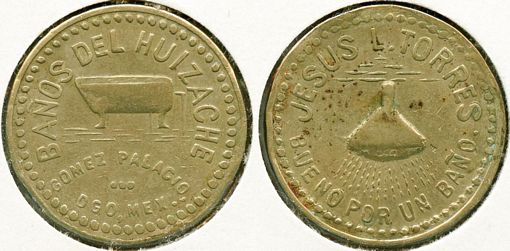
Obverse: BAÑOS DE HUIZACHE / GOMEZ PALACIO / DGO. MEX.
Reverse: JESUS L. TORRES / BUENO POR UN BAÑO
La Amistad
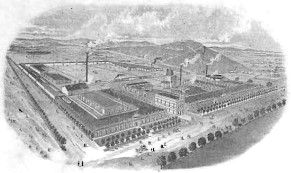
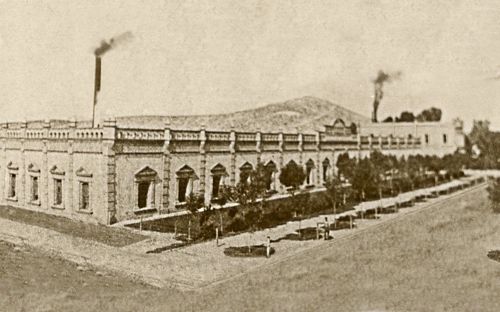
La Amistad, a textile company, was founded by Santiago Prince, Miguel Torres and Dr. Francisco Prince in 1887 and established a cotton spinning and weaving factory, located two blocks from the main square of Gómez Palacio. It had 36 looms (later increased to 45) with all the corresponding preparation machinery, and was supplied with cotton from the Hacienda Soledad and the ranches Las Margaritas, Fresno del Sur and El Refugio, in Matamoros, Coahuila, all owned by the company. The factory processed more than 2,500 bales of cotton a year.
The factory buildings occupied a square of 250 metres per side. In front of the factory were located the workers' houses, 8 blocks of 80 square metres each. The offices or offices were in the middle of the two factories, one of blankets and coarse fabrics, and the other of imperials and thin fabrics.
The company employed more than 800 workers who were provided with comfortable homes. As the factory had its own doctor, he was in charge, at the company's expense, of attending to the sick workers to whom the company itself provided free of charge all the medicines that were necessary. Their salaries were "good", to the extent that some of them made savings that allowed them, after a while, to build up a fund for their children.
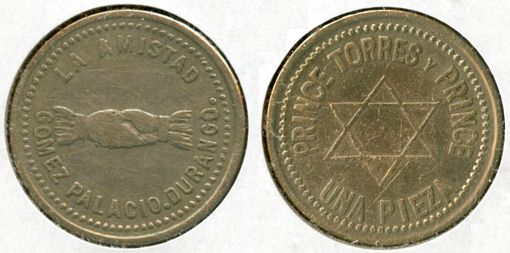
Obverse: LA AMISTAD / GOMEZ PALACIO.DURANGO.
Reverse: PRINCE TORRES Y PRINCE / UNA PIEZA around star of David
Cantina y Billares del Centro
This cantina, owned by Santos Herrero, was located at the corner of 3a calle de Hidalgo and 4a de Gómez PalacioDirectorio de la Laguna, 1908.
It was burnt down when the Villistas captured the town in July 1913.
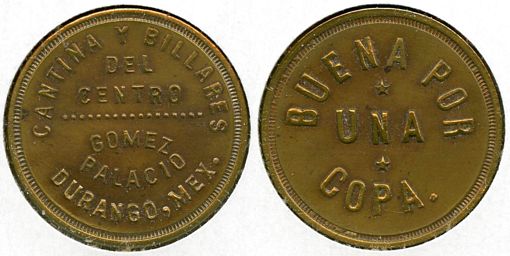
Obverse: CANTINA Y BILLARES / DEL / CENTRO / GOMEZ / PALACIO / DURANGO,MEX.
Reverse:BUENA POR / UNA / COPA.
Mapimí
Yndalecio Valadez
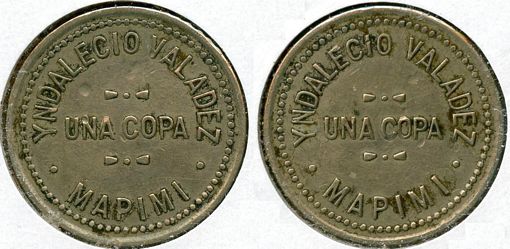
Obverse: YNDALECIO VALADEZ / UNA COPA / MAPIMI
Reverse: YNDALECIO VALADEZ / UNA COPA / MAPIMI
La Unión
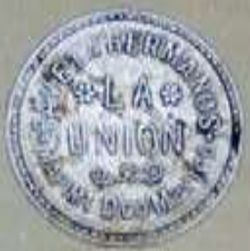
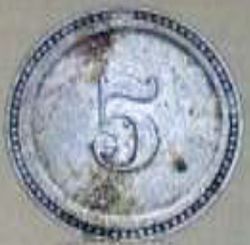
Obverse: FAVELA HERMANOS / LA / UNION / MAPIMI DURANGO MEX.
Reverse: 5
Peñon Blanco
Fabrica La Concha
This was a cottin and print millCommercial Directory of American Republics, 1899.
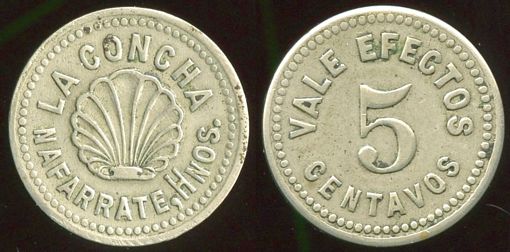
Obverse: LA CONCHA / NAFARRATE, HNOS.
Reverse: VALE EFECTOS / 5 / CENTAVOS
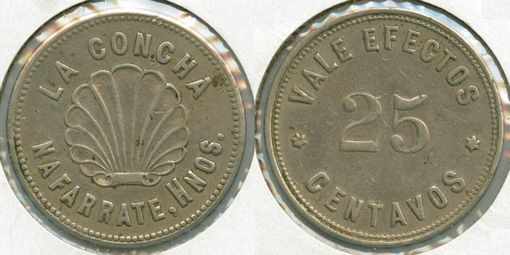
Obverse: LA CONCHA / NAFARRATE, HNOS.
Reverse: VALE EFECTOS / 25 / CENTAVOS
Obverse: LA CONCHA / NAFARRATE, HNOS.
Reverse: VALE EFECTOS / 99 / CENTAVOS
